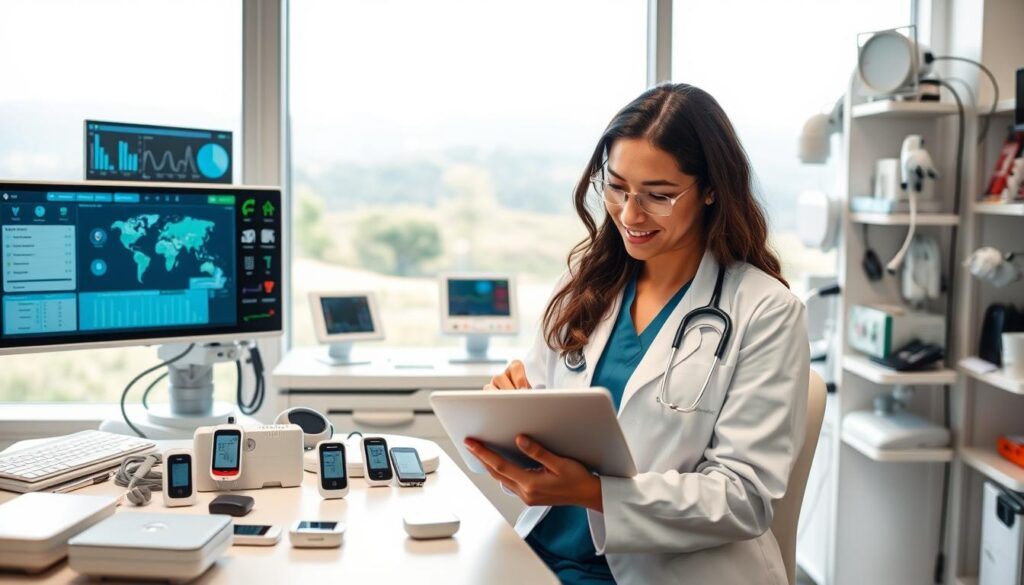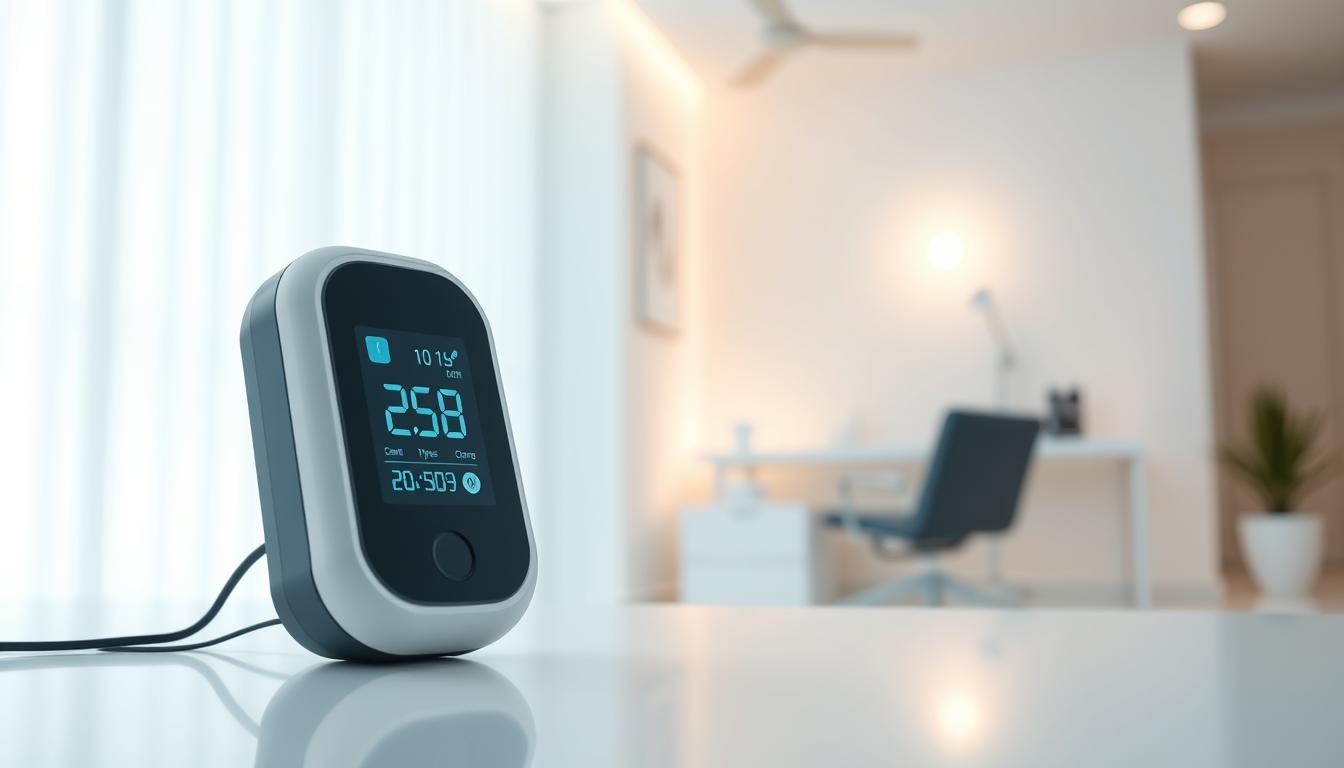The number of people with diabetes in the U.S. has grown from 11 million in 2000 to about 30 million by 20201. This shows we need better ways to manage diabetes, like CGMs. These devices are changing how we care for diabetes. About 90% to 95% of people with diabetes have type 2, making CGMs very important.
Experts think the number of people with type 2 diabetes will reach nearly 55 million by 20301. This makes CGMs even more crucial for the future of diabetes care.
CGMs have been around since 19991. They’ve gotten better, lasting up to 14 days now, compared to just a few days before1. They’re key to managing diabetes because they let us monitor glucose levels in real-time. This helps control diabetes better.
Key Takeaways
- CGMs are revolutionizing the future of diabetes care with real-time glucose monitoring and improved diabetes control.
- The prevalence of diabetes mellitus in the U.S. has increased significantly, making CGMs a crucial tool for management.
- Approximately 90% to 95% of the diabetic population is classified as type 2 diabetes, highlighting the importance of CGMs.
- CGMs have been commercially available since 1999 and have undergone significant advancements in recent years.
- The future of diabetes care relies heavily on CGMs, which provide improved sensor performance and longer lifespans.
- CGMs are expected to play a vital role in managing the predicted rise in type 2 diabetes cases by 20301.
Understanding Continuous Glucose Monitoring Systems
Continuous glucose monitoring (CGM) systems have changed how we manage diabetes. They give us real-time glucose data, helping us make better choices and control our blood sugar levels2. These systems check our glucose levels every few minutes. They show us how our glucose levels change during the day and night3.
CGM systems have a sensor, transmitter, and receiver. The sensor checks glucose levels in our body’s fluid. Then, it sends this info to the receiver, giving us updates and alerts for high or low glucose3. This tech has made life better for people with diabetes, helping them stay in the right blood sugar range more often2.
Using CGM systems can lower the risk of serious health problems. These include amputations, kidney disease, and eye issues2. They also cut down on the need for finger-prick tests, making it easier to manage our glucose levels every day3. As CGM tech gets better, like with implantable sensors and closed-loop systems, it’s becoming key for managing diabetes effectively2.
The Evolution of Diabetes Management Technology
Managing type 2 diabetes has changed a lot over time. New technology has been key in making care better. Continuous glucose monitoring (CGM) systems are a big step forward2.
CGM systems let people with type 2 diabetes keep an eye on their blood sugar levels in real time. This helps them manage their diabetes more effectively.
Studies show that CGM systems help lower HbA1c levels and reduce hypoglycemia in both type 1 and type 2 diabetes patients4. The first big study on CGMs was in 20064. Since then, these systems have gotten better, with more accurate readings and easier to use.
CGM systems offer many benefits for type 2 diabetes management. They help control blood sugar, lower the risk of serious problems, and improve life quality2. With more people getting type 2 diabetes, finding better ways to care for them is crucial. As technology keeps improving, we can expect even more helpful tools for managing type 2 diabetes.
How CGMs Transform Daily Diabetes Care
Glucose monitoring systems have changed how people manage diabetes. They track glucose levels in real-time, helping make better choices about food, exercise, and medicine5. This has made diabetes care easier, reducing the stress it brings.
Studies show that using CGMs can lower HbA1c levels by 0.5% to 1.0% in adults with type 2 diabetes on insulin6.
CGMs do more than just track glucose. They help spot trends and fit into daily life. For instance, a study found CGM use led to a 0.62% drop in A1c levels compared to not using them7. They also cut down severe hypoglycemic episodes by 25%6.
Some key benefits of CGMs include:
- Improved glucose control
- Reduced hypoglycemic episodes
- Enhanced lifestyle integration
CGMs have greatly improved daily diabetes care. They give people the tools and knowledge to manage their diabetes well. By using CGMs, individuals can better control their diabetes and lower the risk of serious problems5.
CGMs: The Future of Type 2 Diabetes Care and Management
The future of diabetes care is changing fast, with Continuous Glucose Monitoring Systems (CGMs) at the forefront. They help improve health and cut down on healthcare costs8. CGMs offer real-time glucose data, helping people make better choices and manage their diabetes better8.
Studies show that more adults will have diabetes, from 537 million in 2021 to over 1.3 billion by 20508.
CGMs are great because they measure glucose continuously, cutting down on the need for fingerstick tests8. They work well with other treatments like GLP-1 agonists to better control glucose levels8. They also help reduce hypoglycemia and make glucose levels more stable9.
The following table highlights the benefits of CGMs in improving health outcomes:
| Benefit | Description |
|---|---|
| Improved glycemic control | CGMs provide real-time glucose data, enabling informed decisions and improving glycemic control8 |
| Reduced hypoglycemia | CGMs can reduce the incidence and duration of hypoglycemia9 |
| Decreased glycemic variability | CGMs can decrease glycemic variability, leading to improved health outcomes9 |
In conclusion, CGMs are key to the future of diabetes care. They offer many benefits, like better health outcomes and lower healthcare costs8. As diabetes becomes more common, the role of CGMs in managing it will grow even more8.
Advanced Features of Modern CGM Systems
Modern continuous glucose monitoring (CGM) systems have changed a lot. They now offer advanced features that help manage diabetes better. These features aim to improve blood sugar control, lower the risk of low blood sugar, and make life better for people with diabetes. The use of diabetes technology in CGM systems has been key to these improvements.
CGM can cut the risk of low blood sugar by 33% to 50% in those at high risk10. This is a big plus, as low blood sugar can be very dangerous. Also, the best CGM sensors are about ±10% MARD accurate10. This accuracy is vital for reliable blood sugar tracking.
Smartphone Integration
Smartphone integration is a major feature of modern CGM systems. It lets users check their blood sugar levels on their phones. This makes tracking easier and more convenient, helping with better diabetes care.
Predictive Alerts
Predictive alerts are another advanced feature. They use algorithms to forecast potential blood sugar highs or lows. This lets users act early to avoid these issues, improving blood sugar control and lowering diabetes risks11.
In summary, the latest features in CGM systems, like smartphone integration and predictive alerts, are changing continuous glucose monitoring and diabetes technology. These features not only help control blood sugar but also make managing diabetes easier and more convenient12.
Benefits for Healthcare Providers and Patient Care
Healthcare providers are key in managing type 2 diabetes. Continuous Glucose Monitoring (CGM) systems are a valuable tool for them13. These systems help patients control their glucose levels better, reduce hypoglycemia, and improve their quality of life13. They also give healthcare providers insights into patient glucose patterns, helping them make better treatment decisions14.
CGM systems offer many benefits for healthcare providers and patient care. These include:
- Improved glucose control and reduced hypoglycemia13
- Enhanced quality of life for patients13
- Valuable insights into patient glucose patterns14
- Potential for reduced healthcare costs and improved health outcomes13
CGM systems have the power to change diabetes care and management. Healthcare providers can greatly help by using these systems to improve patient outcomes14.

Addressing Common Concerns and Limitations
Diabetes care often raises questions about continuous glucose monitoring (CGM) systems. People worry about their accuracy. Studies show CGM devices can give blood glucose readings every 1 to 5 minutes, offering a continuous glucose trace9.
The accuracy of CGM sensors has also improved. Now, they are as accurate as self-monitoring of blood glucose (SMBG) devices, with a mean absolute relative difference (MARD) of less than 10%9.
Cost and insurance coverage are also concerns. While CGM systems can be pricey, many insurance providers now cover them. This makes them more accessible to those with diabetes15. Studies also show CGM systems can lead to significant reductions in HbA1c levels. Adults with type 2 diabetes can see reductions of up to 1.0%6.
CGM systems have become more user-friendly and discreet. Many devices feature small sensors and wearable transmitters9. Despite common concerns and limitations, the benefits of CGM systems in diabetes care and management are significant.
Integration with Artificial Intelligence and Machine Learning
Continuous Glucose Monitoring systems (CGMs) are getting smarter thanks to artificial intelligence and machine learning. This tech helps track glucose levels more accurately, making it easier for people with diabetes to manage their health16. It also lowers the chance of low blood sugar and boosts overall well-being.
Studies show that machine learning can predict low blood sugar with great accuracy. One model was 92% sensitive and 70% specific16. Artificial intelligence is also good at spotting diabetic retinopathy early, helping prevent eye damage17.
The advantages of combining CGMs with AI and machine learning are many. They include:
- Improved glucose control and reduced hypoglycemia
- Enhanced quality of life and reduced healthcare costs
- Personalized diabetes management and treatment plans
As diabetes cases keep rising, with 1.31 billion people expected by 205016, this tech is key. It will change how we care for diabetes. Artificial intelligence helps make treatment plans that really work for each person, improving their lives and cutting healthcare costs.
The Economic Impact of CGM Adoption
Continuous glucose monitoring (CGM) systems can greatly lower healthcare costs and improve health outcomes18. They offer real-time glucose tracking and help spot patterns. This helps people with diabetes manage their condition better, reducing risks and costs. The economic benefits of CGM adoption are key for healthcare providers, payers, and patients.
Research shows CGM use can lower HbA1c levels and increase time in range19. These improvements can save money by reducing healthcare needs and costs. CGMs also cut down on daily test strip use and nonsevere hypoglycemic events, saving more money18.
The cost savings from CGM adoption are substantial, with savings of $11,032 for the CGM group compared to $7,236 for the control group18. As CGMs become more common, understanding their economic impact is crucial. It helps in integrating them into diabetes care to enhance health and cut costs.

Latest Research and Clinical Studies
Recent studies show that Continuous Glucose Monitoring (CGM) systems greatly improve glucose control in type 2 diabetes patients20. The research found that 63% of CGM users had an HbA1c under 8.0%, compared to 39% of those using finger-stick readings. This is a 62% increase20.
CGM systems offer many benefits, like better glucose control and less hypoglycemia. Users spent 3.8 hours more daily in the optimal blood glucose range (70-180 mg/dL)20. Also, CGM systems are now FDA cleared for use with smart devices or receivers21.
Some key findings from the latest research are:
- Lowering HbA1c from 9.0% to 8.0% or less greatly reduces type 2 diabetes complications20.
- CGM systems work well with automated insulin delivery systems to control glucose better21.
The latest research emphasizes the role of CGM systems in changing type 2 diabetes care. CGM helps patients manage their glucose levels better. This reduces the risk of complications and improves their quality of life20.
Emerging Trends and Future Developments
The world of glucose monitoring systems is always changing. New trends aim to make monitoring more accurate and easier for patients. Non-invasive technologies are leading the way, offering hope for a less painful future22.
These new tools could change how people with diabetes manage their condition. They promise to make monitoring glucose levels easier and more precise.
One big trend is the creation of smart insulin delivery systems and closed-loop systems. These systems aim to automatically control insulin levels. This could help avoid dangerous blood sugar swings.
Studies show that using continuous glucose monitoring systems can really help control blood sugar levels. The latest tech has a median absolute relative difference (MARD) of under 10%22.
Another exciting trend is the use of artificial intelligence and machine learning. These technologies can predict blood sugar levels and offer personalized advice. This could lead to better health and lower costs for people with diabetes.
As technology keeps advancing, we’ll see even more innovative solutions. These will help improve the lives of those with diabetes, thanks to new trends and tech23.
In conclusion, the future of glucose monitoring systems is bright. Trends are focusing on making monitoring better and easier for patients. With ongoing research and development, we can look forward to even more breakthroughs. This will lead to better health for people with diabetes22.
Conclusion
Continuous Glucose Monitoring systems (CGMs) are changing how we manage diabetes. They let people with diabetes track their blood sugar levels in real-time. This makes it easier to spot patterns and make better care choices5.
CGMs could make diabetes care much better. They help control blood sugar and lower the risk of low blood sugar5.
Using CGMs daily can greatly improve health and life quality. It can also save money on healthcare5. With more people getting diabetes, CGMs are key in managing it. They provide a precise and easy way to check blood sugar, leading to better health.
Studies show CGMs can lower HbA1c levels a lot. The effect size is Hedge’s g = −0.37 (95% CI: −0.63, −0.11, p 3. This shows CGMs can really help control blood sugar. As technology gets better, CGMs will likely become even more important in diabetes care.
FAQ
What is a Continuous Glucose Monitoring (CGM) system?
How do CGMs differ from traditional glucose monitoring methods?
What are the core components of a CGM system?
How have CGMs transformed daily diabetes care?
What are the benefits of CGMs for healthcare providers and patient care?
What are some common concerns and limitations of CGMs?
How can CGMs be integrated with artificial intelligence and machine learning?
What is the economic impact of CGM adoption?
What are some emerging trends and future developments in CGM technology?
What are the latest research and clinical studies on CGMs?
Source Links
- Continuous Glucose Monitoring Devices: Past, Present, and Future Focus on the History and Evolution of Technological Innovation – https://pmc.ncbi.nlm.nih.gov/articles/PMC8120065/
- How CGM Technology Is Transforming Diabetes Management | TechTarget – https://www.techtarget.com/pharmalifesciences/feature/How-CGM-Technology-Is-Transforming-Diabetes-Management
- Continuous Glucose Monitoring – NIDDK – https://www.niddk.nih.gov/health-information/diabetes/overview/managing-diabetes/continuous-glucose-monitoring
- The future is here: an overview of technology in diabetes – Diabetologia – https://link.springer.com/article/10.1007/s00125-024-06235-z
- The Effectiveness of Continuous Glucose Monitoring Devices in Managing Uncontrolled Diabetes Mellitus: A Retrospective Study – https://pmc.ncbi.nlm.nih.gov/articles/PMC10460137/
- Expanding the Role of Continuous Glucose Monitoring in Modern Diabetes Care Beyond Type 1 Disease – Diabetes Therapy – https://link.springer.com/article/10.1007/s13300-023-01431-3
- Continuous glucose monitoring among adults with type 2 diabetes receiving noninsulin or basal insulin therapy in primary care – Scientific Reports – https://www.nature.com/articles/s41598-024-83548-4
- Untitled – https://www.abbott.com/content/dam/corp/abbott/en-us/hub-new/Future-of-Diabetes-Report.pdf
- Continuous Glucose Monitoring Sensors for Diabetes Management: A Review of Technologies and Applications – https://pmc.ncbi.nlm.nih.gov/articles/PMC6712232/
- Continuous Glucose Monitoring: A Review of Recent Studies Demonstrating Improved Glycemic Outcomes – https://pmc.ncbi.nlm.nih.gov/articles/PMC5467105/
- The History, Evolution and Future of Continuous Glucose Monitoring (CGM) – https://www.mdpi.com/2673-4540/6/3/17
- Expanding the Role of Continuous Glucose Monitoring in Modern Diabetes Care Beyond Type 1 Disease – https://pmc.ncbi.nlm.nih.gov/articles/PMC10299981/
- Using Continuous Glucose Monitoring in Clinical Practice – https://pmc.ncbi.nlm.nih.gov/articles/PMC7755046/
- The Future of Continuous Glucose Monitoring – Role of Continuous Glucose Monitoring in Diabetes Treatment – https://www.ncbi.nlm.nih.gov/books/NBK538969/
- Type 2 Diabetes and the Use of Real-Time Continuous Glucose Monitoring – https://pmc.ncbi.nlm.nih.gov/articles/PMC7957379/
- Exploring the progress of artificial intelligence in managing type 2 diabetes mellitus: a comprehensive review of present innovations and anticipated challenges ahead – https://pmc.ncbi.nlm.nih.gov/articles/PMC10757318/
- Artificial intelligence in diabetes management: Advancements, opportunities, and challenges – https://pmc.ncbi.nlm.nih.gov/articles/PMC10591058/
- Cost-effectiveness of Continuous Glucose Monitoring for Adults With Type 1 Diabetes Compared With Self-Monitoring of Blood Glucose: The DIAMOND Randomized Trial – https://pmc.ncbi.nlm.nih.gov/articles/PMC5961392/
- Personal Continuous Glucose Monitoring Use Among Adults with Type 2 Diabetes: Clinical Efficacy and Economic Impacts – https://pmc.ncbi.nlm.nih.gov/articles/PMC8655087/
- New study published in JAMA shows people with Type 2 diabetes on basal insulin benefit from real-time continuous glucose monitoring | HealthPartners – https://www.healthpartners.com/hp/about/press-releases/new-jama-study-shows-people-with-type2-diabetes-benefit-from-real-time-continuous-glucose-monitoring.html
- Dexcom CGM Clinical Trials on Glycemic Control – https://provider.dexcom.com/education-research/clinical-evidence/clinical-studies
- Expanding the horizon of continuous glucose monitoring into the future of pediatric medicine – Pediatric Research – https://www.nature.com/articles/s41390-024-03573-x
- Continuous Glucose Monitoring: Current Use and Future Directions – https://pmc.ncbi.nlm.nih.gov/articles/PMC5164922/




